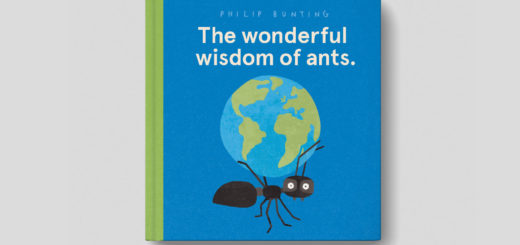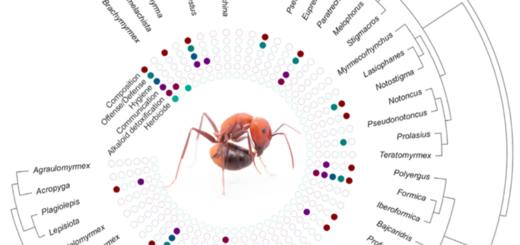From many individuals to one whole
In the recent review article “How to become one: the proximate mechanisms of self-assembly behaviour in social insects (Insecta: Hymenoptera, Apidae)” published in Myrmecological News, Daniele Carlesso and Chris R. Reid review the current literature on the collective behavior of ants, specifically the self-assemblages (i.e., three-dimensional structures). Self-assemblages are dynamic, quickly formed and disassembled. Carlesso and Reid discuss, among others, which factors influence self-assemblages and indicate areas for future studies. Here, Madeleine Beekman highlights the main points of the review.
A Review by Madeleine Beekman

Edited by Phil Hoenle, Patrick Krapf and, Lina Pedraza

Since December 2021, I live in tropical north Queensland, in the midst of the rainforest. Slowly I am starting to get to know whom I am sharing the forest with, but some species were very quick in making their existence known. The green tree ant Oecophylla smaragdina is one such species. (Chris Reid tells me that only locals call them green tree ants—their ‘proper’ name is weaver ants; if Chris is right, that is.) Green tree ants are nasty biters and are not fazed by the difference in size between themselves and their victims. They are also extremely territorial, attacking almost immediately when you find yourself too close to one of their nests. To make things worse, they attack en masse and spray formic acid straight into the bite wound. While I have worked for many years on different species of honeybees, all of whom sting, I do not seem to be able to get used to insects that are so easily provoked as the green tree ants seem to be. But, of course, they are very interesting beasts to study (as are honeybees) because of the amazing feats the insects pull off when working collectively.
Daniele Carlesso and Chris Reid (yes, the same Chris Reid as above) reviewed the basic rules of thumb social insects use to construct structures such as chains (which the green tree ants use to roll up leaves to build a nest), bivouacs (like the amazing army ants), curtains (some species of honeybees) or rafts (fire ants), to name just a few. In other words, how do social insects self-assemble in response to challenges? We all know by now that there is no external force shaping the insects’ collective behaviour but that the individuals instead use a set of relatively simple rules to govern their own. In doing so, they interact not only with others but also with their environment, so that not every individual behaves in exactly the same way. Modeling studies have shown that variation in individuals’ behaviour improves collective decision-making. ‘Mistakes’ can lead to better decisions.
The key to effective self-assemblage is ‘knowing’ when to disassemble and the structure no longer serves a function. Carlesso and Reid therefore, focused both on the kind of information insects use to assemble and disassemble. Not surprisingly, insects use quite similar kinds of information during self-assembly and when disassembling. My favourite simple rule must be ‘don’t move if someone is on top of you’, even though to me that sounds counterintuitive if I was in that situation. But when forming a bridge to cross a gap, for example, no longer perceiving ants walking over you must mean that everyone has passed. Without the need for ants crossing the bridge, the bridge becomes superfluous and the ‘bridge’ ants are free to move. The ‘don’t move’ rule is also applicable to the construction of multiple structures: not only when building bridges, but also when plugging potholes, or making rafts. Pheromones can assist in self-assembly by quickly gathering individuals to where they are needed, mediating interactions amongst individuals. Some pheromones are so potent that they can be used by humans to manipulate the insects. The honeybee’s Nasanov pheromone is commercially available to attract swarms to nest boxes and the queen’s pheromone 9-oxo-(E)-2-decanoic acid, or 9 ODE, can be bought as lures to prevent a queenless colony from absconding.
Honeybees also need to perceive the presence of the queen, by means of pheromones, to form a swarm cluster, even though the formation of the cluster itself depends on more immediate interactions amongst the bees. A swarm cluster will not be initiated in the absence of the queen’s pheromone. Once a cluster is formed, other proximate mechanisms become important to maintain structural integrity. Clusters, or other self-assembled structures, also adapt to their environment. Daniele and Chris call the influence of the environment on self-assembly ‘environmental geometry’. Often environmental geometry affects the final shape of the self-assemblage, especially when the structure is formed inside some shape of cavity, but also when the environment affects the spread of information.
It shouldn’t come as a surprise that many of the proximate mechanisms Daniele and Chris identified are similar to those social insects use in other collective behaviours, such as foraging, nest building, or collective movement. After all, each individual insect has limited information available and limited means to process information. Yet, these simple mechanisms allow them to pull off amazing feats. I know I should be more appreciative of the green tree ants in my rainforest. If only they weren’t so effective at rapidly self-assembling into a biting army.






Recent Comments